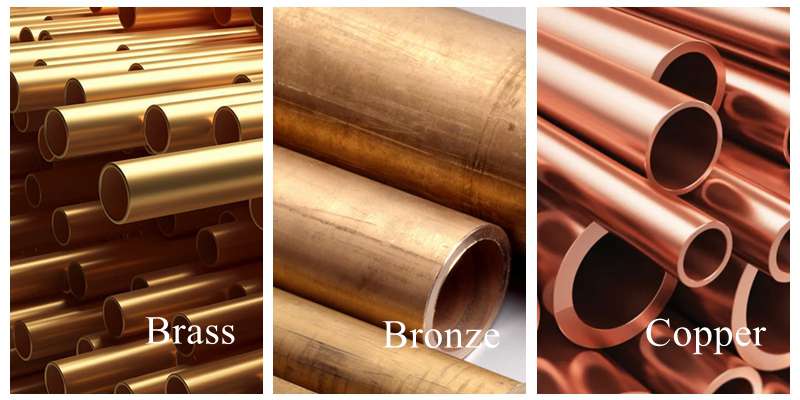Sometimes referred to as the ‘red metals’, copper, brass and bronze can be difficult to tell apart. Similar in colour and often marketed in the same categories, the difference in these metals may surprise you! Please see our comparison chart below to give you an idea:
| Colour | Typical Applications | Benefits | |
| Copper | Orange-tinted red | ● Pipes & pipe fittings ● Wiring |
● High electrical & thermal conductivity ● Easily soldered and very ductile ● Impressive antibacterial properties |
| Brass | Can range from red to gold in colour depending on the level of zinc added to the alloy | ● Decorative items ● Musical instruments |
● Attractive, gold-like colour ● Good workability & durability ● Excellent strength, with over 39% zinc levels |
| Bronze | Dull gold | ● Medals & awards ● Sculptures ● Industrial bushings & bearings |
● Corrosion resistant ● Higher heat and electrical conductivity than most steels. |
1. What is Copper?
Copper is a metallic element found on the periodic table. It is a natural resource that can be found in the earth and is an ingredient in Brass and Bronze. Copper mines extract raw copper from the earth’s surface and can be found all over the world. Because this metal is highly conductive and capable of withstanding heat, it is often used in electrical systems and computers. Copper pipes are also frequently used in plumbing. Some of the most common items made from copper that are recycled at scrap yards include copper wire, cable, and tubing. Copper is one of the highest valued metals at scrap yards.
2. What is Brass?
Brass is a metal alloy, which means it is a metal made up of multiple elements. It is a mixture of copper and zinc, and sometimes tin. Differences in the percentages of copper and zinc can produce variations in the color and properties of brass. It’s appearance ranges from yellow to a dull gold. More zinc makes the metal stronger and more ductile, and it makes the color more yellow. Because of its durability and workability, brass is commonly used in plumbing fixtures, mechanical components, and musical instruments. It is also used for decorative purposes because of its gold appearance.
3. What is Bronze?
Like brass, bronze is a metal alloy that is made up of copper and other elements. In addition to copper, tin is the most common element found in bronze, but bronze can also contain zinc, arsenic, aluminum, silicon, phosphorus, and manganese. Each combination of elements produces different properties in the resulting alloy. The addition of other elements makes bronze much harder than copper alone. Because of its dull-gold appearance and strength, bronze is used in sculptures, musical instruments, and medals. It is also used in industrial applications like bearings and bushings because of its low metal-on-metal friction. Bronze has additional nautical uses due to its resistance to corrosion. It is also a good conductor of heat and electricity.
4. Differences Between Copper, Brass, and Bronze
Brass and bronze are both partially comprised of copper, which is why it can sometimes be difficult to tell the difference between the metal and its alloys. However, each one has certain characteristics and properties that make it unique and distinguishable from the others. Here are some ways to tell copper, brass, and bronze apart from one another.
● Color
Copper has a distinctive reddish-brown color. Brass has a brighter yellowish-gold appearance. Bronze, meanwhile, is a duller gold or sepia color and will typically have faint rings on its surface.
● Sound
You can lightly strike the metal to test whether it is copper or an alloy. Copper will produce a deep, low sound. Brass and bronze will produce a higher-pitched sound, with brass sounding brighter.
● Composition
Copper is an element in the periodic table, which means the only ingredient in pure copper is copper. However, it sometimes will have impurities or traces of other materials mixed in. Brass is an alloy of the elements copper and zinc and can contain tin and other metals as well. Bronze is an alloy of the elements copper and tin, though sometimes silicon, manganese, aluminum, arsenic, phosphorus, or other elements are added. Bronze and Brass can contain many of the same metals, but modern bronze typically has a higher percentage of Copper—about 88% on average.
● Magnetism
Copper, brass, and bronze are all technically non-ferrous and should not be magnetic. However, since brass and bronze are alloys, sometimes traces of iron can make their way into them and may be able to be detected by a strong magnet. If you hold a strong magnet to the metal in question and it responds, then you can rule out that it is copper.
● Durability
Bronze is hard, sturdy, and not easily flexed. Brass is the least durable, with copper in the middle. Brass can crack much more easily than the other two. Copper, meanwhile, is the most flexible of the three. Brass is also more resistant to corrosion than copper, but not as resistant as bronze. Copper will oxidize over time and form a green patina to protect it from further corrosion.
Want to learn more about the difference between copper and brass? Let the experts at JINDALAI work with you to select just the right metals for your next project. Call today to speak to a friendly, knowledgeable team member.
HOTLINE: +86 18864971774 WECHAT: +86 18864971774 WHATSAPP: https://wa.me/8618864971774
EMAIL: jindalaisteel@gmail.com sales@jindalaisteelgroup.com WEBSITE: www.jindalaisteel.com
Post time: Dec-19-2022









